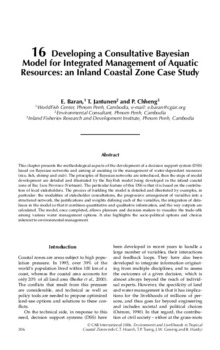Developing a consultative Bayesian model for integrated management of aquatic resources: an inland coastal zone case study.

Citation
Baran, E.; Jantunen, T.; Chheng, P. (2006). Developing a consultative Bayesian model for integrated management of aquatic resources: an inland coastal zone case study.. p. 206-218. In: Comprehensive Assessment of Water Management in Agriculture Series 2 - Environment and livelihoods in tropical coastal zones: Managing agriculture-fishery-aquaculture conflicts
This article presents the methodological aspects of the development of a decision support system (DSS) based on Bayesian networks and aiming at assisting in the management of water-dependent resources (rice, fish, shrimp and crab). The principles of Bayesian networks are introduced, then the steps of model development are detailed and illustrated by the BayFish model being developed in the inland coastal zone of Bac Lieu Province (Vietnam). The particular feature of this DSS is that it is based on the contribution of local stakeholders. The process of building the model is detailed and illustrated by examples, in particular: the modalities of stakeholder consultations, the progressive arrangement of variables into a structured network, the justifications and weights defining each of the variables, the integration of databases in the model so that it combines quantitative and qualitative information, and the way outputs are calculated. The model, once completed, allows planners and decision-makers to visualize the trade-offs among various water management options. It also highlights the socio-political options and choices inherent to environmental management.
Permalink
Date Available
Type
Publisher
Language